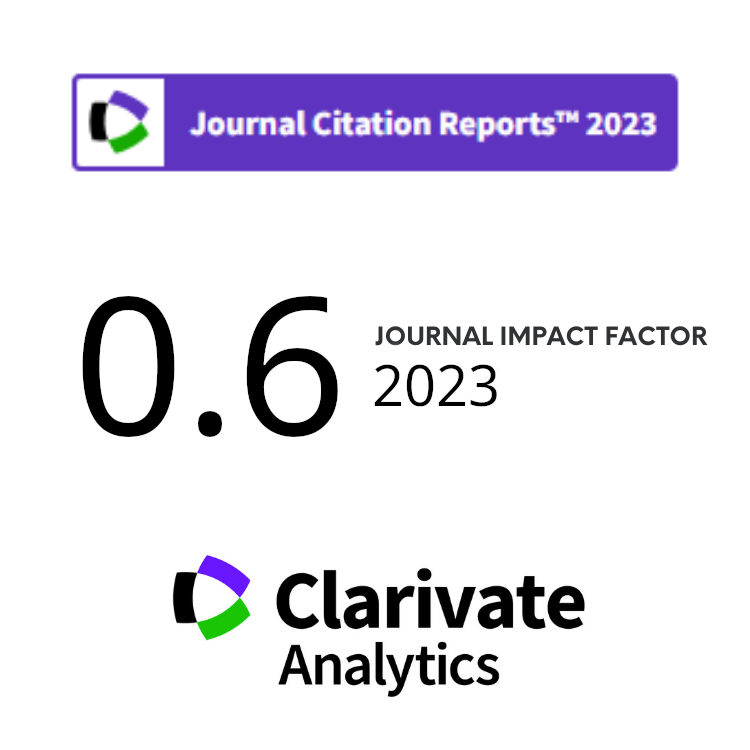Radiological Risk to Inhalation of Thoron Gas from Medical Materials Samples Derived from Medical Plants in Iraq
Abstract
Pollution by thoron is one of the factors that is harmful to human health. Medical materials, especially those derived from plants, have natural ingredients which are a major source of natural radioactivity, thoron being one of them. Therefore, the presence of harmful radioactivity in these materials is a matter of concern. This study determined the concentrations of thoron (220Rn or radon-220) from 70 samples of medical materials derived from medical plants using a CR-39 detector. Samples are drugs (solid), skin creams, herbs, toothpaste, drugs (liquid), and cosmetic products found in Iraqi pharmacies. Also, radiological risks such as Annual Effective Dose (AED), Excessive Lifetime Cancer Risk (ELCR), and Lung Cancer Case (LCC) due to inhalation of thoron from medical materials samples in pharmacies were calculated. The results show that the results of the thoron concentrations in the samples of medical materials ranged from 1.02 Bq/m3 to 74.53 Bq/m3, with an average value of 18.21 ± 2.00 Bq/m3. The range values of AED, ELCR (×10-3) and LCC (×10-6) were 0.01-0.588 mSv/y, 0.04-2.36, and 0.18-10.58, respectively. It was als found that the thoron concentrations in samples of the present study vary from a minimum of 12.82 Bq/m3 in cosmetic products samples to a maximum of 30.29 Bq/m3 in herbs samples. Nonetheless, all thoron and radiological risk values were lower than the acceptable world limit (thoron = 200-300 Bq/m3 by ICRP and AED = 1.1-4.4 mSv/y by UNSCEAR).
Full Text:
PDFReferences
A. A. Abojassim, R. H. Hashim and N. S. Mahdi, Basics of Nuclear Radiation, BP International (2021) 1.
K. Heyde, Basic Ideas and Concepts in Nuclear Physics: An Introductory Approach, CRC Press (2020).
G. V. Kozmin, S. Fesenko, A. S. Snegirev et al., J. Environ. Radioact. 213 (2020) 106111.
A. A. Abojassim, H. A. A. Mraity, A. A. Husain et al., Nucl. Phys. At. Energy 18 (2017) 276.
A. A. A. Al-Hamidawi, Sci. Technol. Nucl. Install. 2015 (2015) 1.
S. Akbar, Handbook of 200 Medicinal Plants: A Comprehensive Review of Their Traditional Medical Uses and Scientific Justifications (2020).
D. J. Lawi, W. S. Abdulwhaab and A. A. Abojassim, Biol. Trace Elem. Res. 201 (2023) 3528
M. Misdaq, F. A. Nouh and W. Bourzik, J. Radioanal. Nucl. Chem. 247 (2001) 357.
H. Harrass, R. Touti, M. B. El Fakir et al., Radiat. Phys. Chem. 218 (2024) 111610.
S. K. Sahoo, M. Katlamudi and B. C. P, J. Radioanal. Nucl. Chem. (2023) 1.
A. A. Abojassim and D. J. Lawi, Plant Archives 18 (2018) 1137.
H. N. Alkhafaji, A. A. Abojassim and A. A. Alkufi, J. Phys.: Conf. Ser. 1234 (2019) 012002.
A. A. Abojassim, J. Nucl. Eng. Radiat. Sci. 7 (2021) 032001.
Z. S. Hamzah, A. K. Hashim and A. A. Abojassim, Iran. J. Sci. Technol. Trans. Sci. 46 (2022) 989.
A. A. Marzaali, M. A. Al-Shareefi and A. A. Abojassim, Water Supply 22 (2022) 1035.
B. Vrban, J. Lüley, S. Čerba et al., Radiat. Prot. Dosim. 198 (2022) 687.
N. F. Salih, H. M. Salh and A. M. Hamad, Innovaciencia 6 (2018) 1.
B. K. Sahoo, B. K. Sapra, S. D. Kanse et al., Radiat. Meas. 58 (2013) 52.
F. Fábián, A. Csordás, A. Shahrokhi et al., Radiat. Prot. Dosim. 160 (2014) 169.
A. Csordás, F. Fábián, G. Bátor et al., Radiat. Environ. Med. 7 (2018) 53.
A. A. Abojassim, D. J. Lawi and E. F. Salman, Prensa Med. Argent. 106 (2020) 1.
M. Janik, S. Tokonami, C. Kranrod et al., J. Rad. Res. 54 (2013) 597.
UNSCEAR. Sources and Effects of Ionizing Radiation. United Nations Scientific Committee on the Effects, New York, USA (2000).
G. La Verde, V. Artiola, M. La Commara et al., Life 12 (2022) 246.
F. Paquet, M. Bailey, R. Leggett et al., ICRP Publication 137: Occupational Intakes of Radionuclides: Part 3, 46 (2017) 1.
S. Sherafat, S. N. Mansour, M. Mosaferi, MethodsX 6 (2019) 2205.
International Commission on Radiological Protection (ICRP). Lung Cancer Risk from Radon and Progeny and Statement on Radon, 40 (2010).
H. J. Nasser, I. T. Al-Alawy and O. A. Mzher. J. Phy. Conf. Ser. 1660 (2020) 012064.
S. Sharma, K. Mehta, S. Narang et al., Groundwater Sustainable Dev. 11 (2020) 100409.
United Nations Scientific Committee on the Effects of Atomic Radiation (UNSCEAR). Effects of Ionizing Radiation, United Nations Scientific Committee on the Effects of Atomic Radiation (UNSCEAR) 2006 Report, Volume I: Report to the General Assembly, Scientific Annexes A and B. United Nations (2008).
L. Oufni, N. Manaut, S. Taj et al., Am. J. Environ. Prot. 1 (2013) 34.
DOI: https://doi.org/10.55981/aij.2024.1329
Copyright (c) 2024 Atom Indonesia

This work is licensed under a Creative Commons Attribution-NonCommercial-ShareAlike 4.0 International License.











